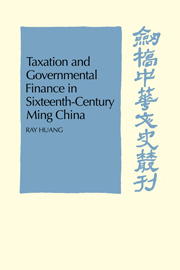Book contents
- Frontmatter
- Contents
- List of figures
- List of tables
- Preface by D. C. Twitchett
- Acknowledgements
- A note on weights and measures
- The Ming emperors
- Map of Ming provinces
- 1 Fiscal organization and general practices
- 2 The heritage of the sixteenth century and major fiscal problems
- 3 The land tax—(i) Tax structure
- 4 The land tax—(ii) Tax administration
- 5 The salt monopoly
- 6 Miscellaneous incomes
- 7 Financial management
- 8 Concluding observations
- List of abbreviations
- Appendixes
- Notes to the text
- Bibliography
- Glossary index
- General index
4 - The land tax—(ii) Tax administration
Published online by Cambridge University Press: 04 August 2010
- Frontmatter
- Contents
- List of figures
- List of tables
- Preface by D. C. Twitchett
- Acknowledgements
- A note on weights and measures
- The Ming emperors
- Map of Ming provinces
- 1 Fiscal organization and general practices
- 2 The heritage of the sixteenth century and major fiscal problems
- 3 The land tax—(i) Tax structure
- 4 The land tax—(ii) Tax administration
- 5 The salt monopoly
- 6 Miscellaneous incomes
- 7 Financial management
- 8 Concluding observations
- List of abbreviations
- Appendixes
- Notes to the text
- Bibliography
- Glossary index
- General index
Summary
The operations of the tax system were considerably hindered by its rigidly predetermined nature and numerous inconsistencies. This was illustrated in the previous chapter. Despite the fact that in the late sixteenth century its collection was put on a much broader basis, the earlier practice of minutely-specified tax assessment continued. The general rates were complicated by the addition of fractional sums; in the assessment of each taxpayer's burden every item of state expenditure had to be considered separately. Such a scheme would be difficult to carry out even in a modern society, with all the benefits of computerized accounting. Local government in the Ming was hardly equipped for the task.
Moreover, to maintain taxation on its broad and general basis, it was necessary to protect individual taxpayers from unfair practice and extortion, if their equality of treatment were not to remain purely theoretical. The Ming government made no such attempt and consequently the tax administration, while appearing fairly solid and well constructed at the top, remained in a rather ramshackle state on the lower levels. As in the rest of the power structure, responsibility in fiscal matters followed an upward direction, from the lower offices to the higher, and from the populace to the government. The higher offices were in no way accountable to their subordinates, nor were they even compelled to solve their technical problems. The impracticalities of the system thus accumulated at the lowest level, creating a wide gap between theory and practice.
- Type
- Chapter
- Information
- Publisher: Cambridge University PressPrint publication year: 1975

